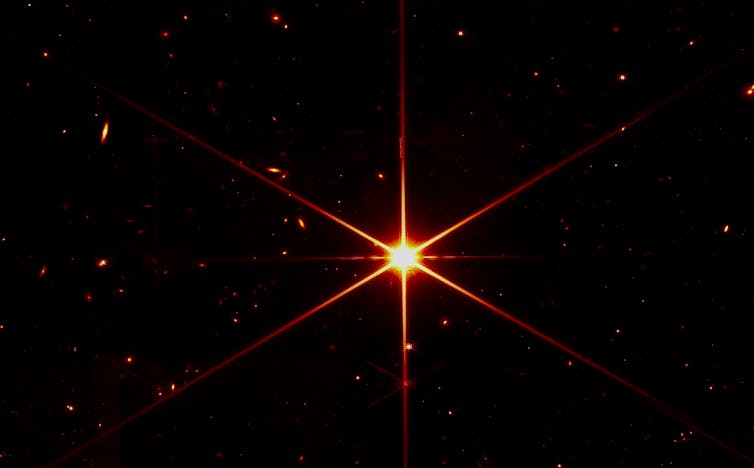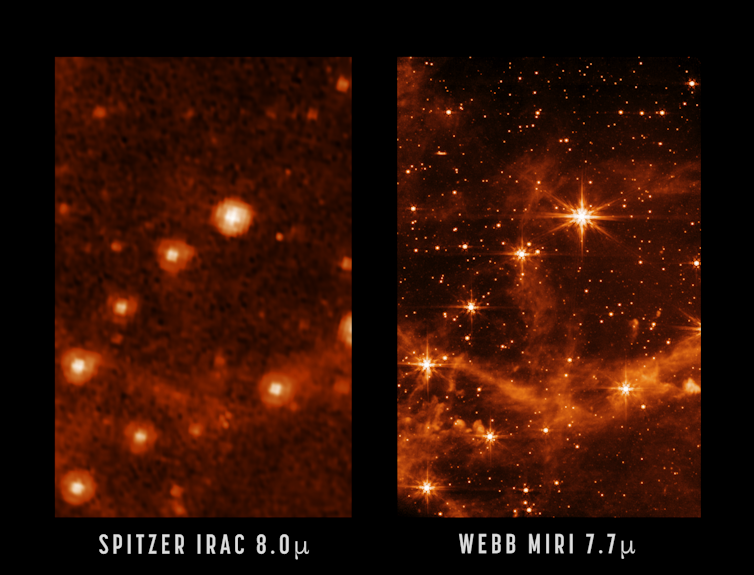
NASA is scheduled to release the first images taken by the James Webb Space Telescope on July 12, 2022. They’ll mark the beginning of the next era in astronomy as Webb – the largest space telescope ever built – begins collecting scientific data that will help answer questions about the earliest moments of the universe and allow astronomers to study exoplanets in greater detail than ever before. But it has taken nearly eight months of travel, setup, testing and calibration to make sure this most valuable of telescopes is ready for prime time. Marcia Rieke, an astronomer at the University of Arizona and the scientist in charge of one of Webb’s four cameras, explains what she and her colleagues have been doing to get this telescope up and running.
1. What’s happened since the telescope launched?
After the successful launch of the James Webb Space Telescope on Dec. 25, 2021, the team began the long process of moving the telescope into its final orbital position, unfolding the telescope and – as everything cooled – calibrating the cameras and sensors onboard.
The launch went as smoothly as a rocket launch can go. One of the first things my colleagues at NASA noticed was that the telescope had more remaining fuel onboard than predicted to make future adjustments to its orbit. This will allow Webb to operate for much longer than the mission’s initial 10-year goal.
The first task during Webb’s monthlong journey to its final location in orbit was to unfold the telescope. This went along without any hitches, starting with the white-knuckle deployment of the sun shield that helps cool the telescope, followed by the alignment of the mirrors and the turning on of sensors.
Once the sun shield was open, our team began monitoring the temperatures of the four cameras and spectrometers onboard, waiting for them to reach temperatures low enough so that we could start testing each of the 17 different modes in which the instruments can operate.

2. What did you test first?
The cameras on Webb cooled just as the engineers predicted, and the first instrument the team turned on was the Near Infrared Camera – or NIRCam. NIRCam is designed to study the faint infrared light produced by the oldest stars or galaxies in the universe. But before it could do that, NIRCam had to help align the 18 individual segments of Webb’s mirror.
Once NIRCam cooled to minus 280 F, it was cold enough to start detecting light reflecting off of Webb’s mirror segments and produce the telescope’s first images. The NIRCam team was ecstatic when the first light image arrived. We were in business!
These images showed that the mirror segments were all pointing at a relatively small area of the sky, and the alignment was much better than the worst-case scenarios we had planned for.
Webb’s Fine Guidance Sensor also went into operation at this time. This sensor helps keep the telescope pointing steadily at a target – much like image stabilization in consumer digital cameras. Using the star HD84800 as a reference point, my colleagues on the NIRCam team helped dial in the alignment of the mirror segments until it was virtually perfect, far better than the minimum required for a successful mission.
3. What sensors came alive next?
As the mirror alignment wrapped up on March 11, the Near Infrared Spectrograph – NIRSpec – and the Near Infrared Imager and Slitless Spectrograph – NIRISS – finished cooling and joined the party.
NIRSpec is designed to measure the strength of different wavelengths of light coming from a target. This information can reveal the composition and temperature of distant stars and galaxies. NIRSpec does this by looking at its target object through a slit that keeps other light out.
NIRSpec has multiple slits that allow it to look at 100 objects at once. Team members began by testing the multiple targets mode, commanding the slits to open and close, and they confirmed that the slits were responding correctly to commands. Future steps will measure exactly where the slits are pointing and check that multiple targets can be observed simultaneously.
NIRISS is a slitless spectrograph that will also break light into its different wavelengths, but it is better at observing all the objects in a field, not just ones on slits. It has several modes, including two that are designed specifically for studying exoplanets particularly close to their parent stars.
So far, the instrument checks and calibrations have been proceeding smoothly, and the results show that both NIRSpec and NIRISS will deliver even better data than engineers predicted before launch.

4. What was the last instrument to turn on?
The final instrument to boot up on Webb was the Mid-Infrared Instrument, or MIRI. MIRI is designed to take photos of distant or newly formed galaxies as well as faint, small objects like asteroids. This sensor detects the longest wavelengths of Webb’s instruments and must be kept at minus 449 F – just 11 degrees F above absolute zero. If it were any warmer, the detectors would pick up only the heat from the instrument itself, not the interesting objects out in space. MIRI has its own cooling system, which needed extra time to become fully operational before the instrument could be turned on.
Radio astronomers have found hints that there are galaxies completely hidden by dust and undetectable by telescopes like Hubble that captures wavelengths of light similar to those visible to the human eye. The extremely cold temperatures allow MIRI to be incredibly sensitive to light in the mid-infrared range which can pass through dust more easily. When this sensitivity is combined with Webb’s large mirror, it allows MIRI to penetrate these dust clouds and reveal the stars and structures in such galaxies for the first time.
5. What’s next for Webb?
As of June 15, 2022, all of Webb’s instruments are on and have taken their first images. Additionally, four imaging modes, three time series modes and three spectroscopic modes have been tested and certified, leaving just three to go.
On July 12, NASA plans to release a suite of teaser observations that illustrate Webb’s capabilities. These will show the beauty of Webb imagery and also give astronomers a real taste of the quality of data they will receive.
After July 12, the James Webb Space Telescope will start working full time on its science mission. The detailed schedule for the coming year hasn’t yet been released, but astronomers across the world are eagerly waiting to get the first data back from the most powerful space telescope ever built.
Marcia Rieke, Regents Professor of Astronomy, University of Arizona
This article is republished from The Conversation under a Creative Commons license. Read the original article.











